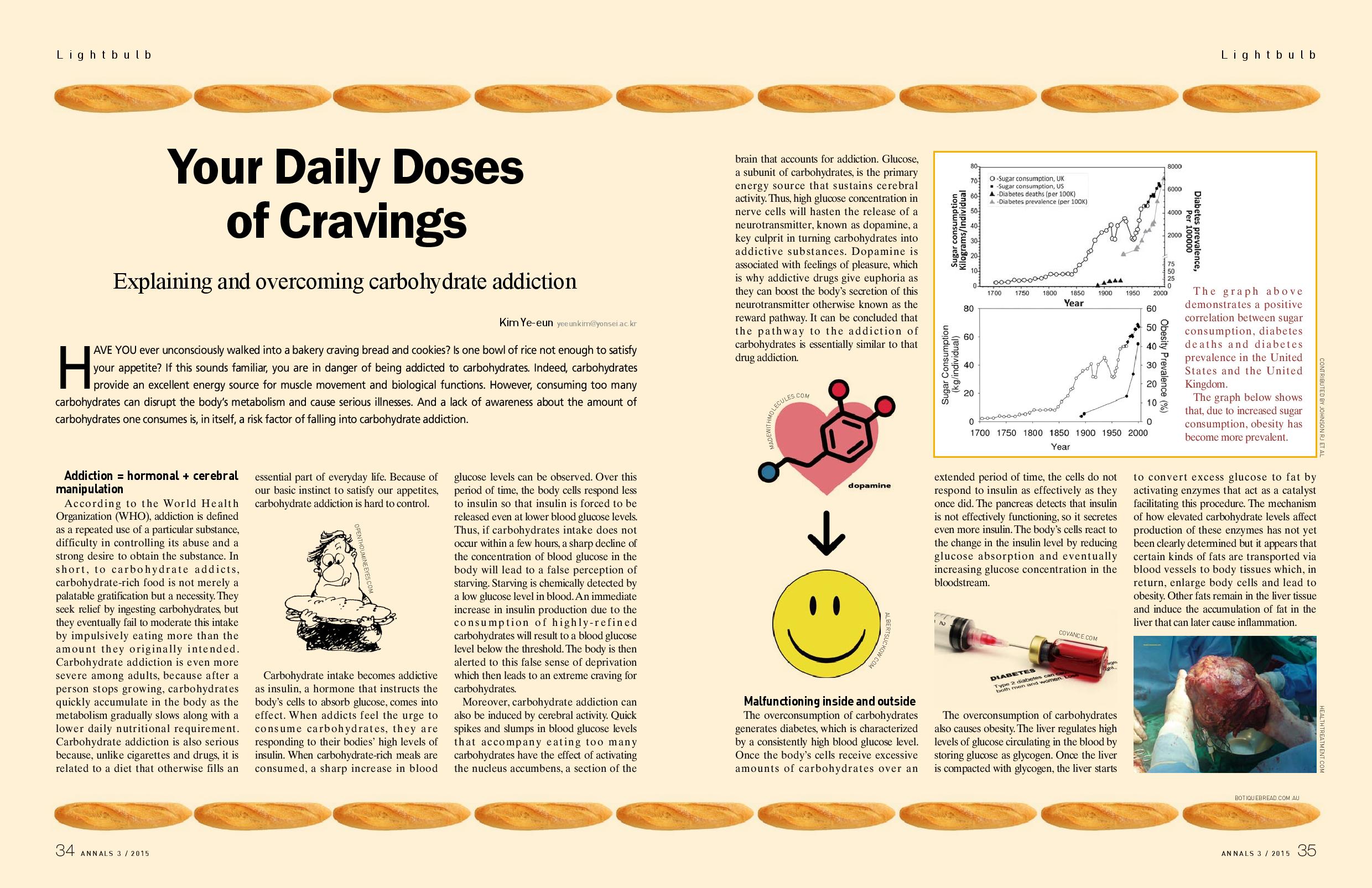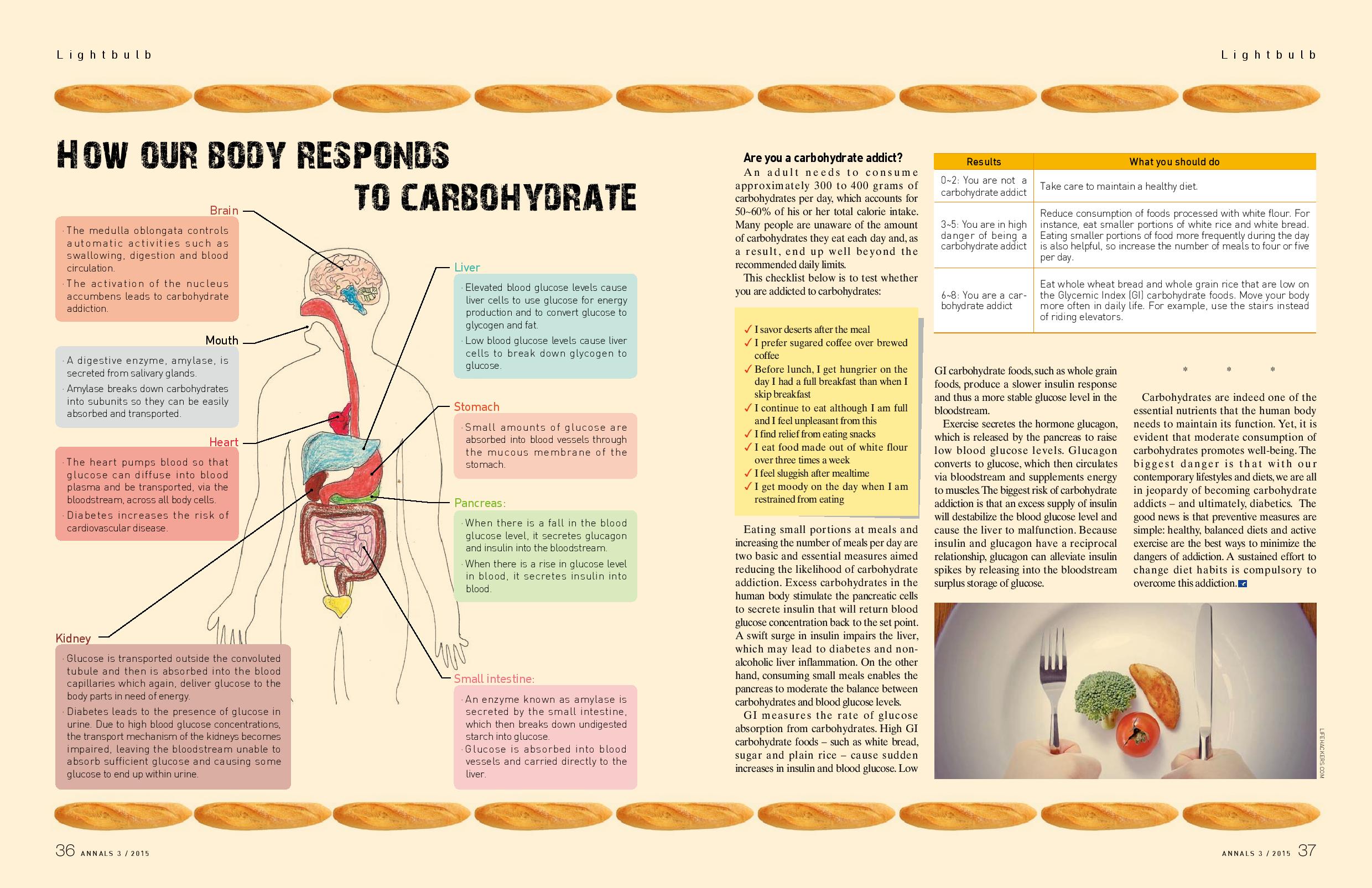Explaining and overcoming carbohydrate addiction
 | ||
 | ||
 | ||
HAVE YOU ever unconsciously walked into a bakery craving bread and cookies? Is one bowl of rice not enough to satisfy your appetite? If this sounds familiar, you are in danger of being addicted to carbohydrates. Indeed, carbohydrates provide an excellent energy source for muscle movement and biological functions. However, consuming too many carbohydrates can disrupt the body’s metabolism and cause serious illnesses. And a lack of awareness about the amount of carbohydrates one consumes is, in itself, a risk factor of falling into carbohydrate addiction.
Addiction = hormonal + cerebral manipulation
According to the World Health Organization (WHO), addiction is defined as a repeated use of a particular substance, difficulty in controlling its abuse and a strong desire to obtain the substance. In short, to carbohydrate addicts, carbohydrate-rich food is not merely a palatable gratification but a necessity. They seek relief by ingesting carbohydrates, but they eventually fail to moderate this intake by impulsively eating more than the amount they originally intended. Carbohydrate addiction is even more severe among adults, because after a person stops growing, carbohydrates quickly accumulate in the body as the metabolism gradually slows along with a lower daily nutritional requirement. Carbohydrate addiction is also serious because, unlike cigarettes and drugs, it is related to a diet that otherwise fills an essential part of everyday life. Because of our basic instinct to satisfy our appetites, carbohydrate addiction is hard to control.
Carbohydrate intake becomes addictive as insulin, a hormone that instructs the body’s cells to absorb glucose, comes into effect. When addicts feel the urge to consume carbohydrates, they are responding to their bodies’ high levels of insulin. When carbohydrate-rich meals are consumed, a sharp increase in blood glucose levels can be observed. Over this period of time, the body cells respond less to insulin so that insulin is forced to be released even at lower blood glucose levels. Thus, if carbohydrates intake does not occur within a few hours, a sharp decline of the concentration of blood glucose in the body will lead to a false perception of starving. Starving is chemically detected by a low glucose level in blood. An immediate increase in insulin production due to the consumption of highly-refined carbohydrates will result to a blood glucose level below the threshold. The body is then alerted to this false sense of deprivation which then leads to an extreme craving for carbohydrates.
Moreover, carbohydrate addiction can also be induced by cerebral activity. Quick spikes and slumps in blood glucose levels that accompany eating too many carbohydrates have the effect of activating the nucleus accumbens, a section of the brain that accounts for addiction. Glucose, a subunit of carbohydrates, is the primary energy source that sustains cerebral activity. Thus, high glucose concentration in nerve cells will hasten the release of a neurotransmitter, known as dopamine, a key culprit in turning carbohydrates into addictive substances. Dopamine is associated with feelings of pleasure, which is why addictive drugs give euphoria as they can boost the body’s secretion of this neurotransmitter otherwise known as the reward pathway. It can be concluded that the pathway to the addiction of carbohydrates is essentially similar to that drug addiction.
Malfunctioning inside and outside
The overconsumption of carbohydrates generates diabetes, which is characterized by a consistently high blood glucose level. Once the body’s cells receive excessive amounts of carbohydrates over an extended period of time, the cells do not respond to insulin as effectively as they once did. The pancreas detects that insulin is not effectively functioning, so it secretes even more insulin. The body’s cells react to the change in the insulin level by reducing glucose absorption and eventually increasing glucose concentration in the bloodstream.
The overconsumption of carbohydrates also causes obesity. The liver regulates high levels of glucose circulating in the blood by storing glucose as glycogen. Once the liver is compacted with glycogen, the liver starts to convert excess glucose to fat by activating enzymes that act as a catalyst facilitating this procedure. The mechanism of how elevated carbohydrate levels affect production of these enzymes has not yet been clearly determined but it appears that certain kinds of fats are transported via blood vessels to body tissues which, in return, enlarge body cells and lead to obesity. Other fats remain in the liver tissue and induce the accumulation of fat in the liver that can later cause inflammation.
How our body responds to carbohydrates
Brain:
l The medulla oblongata controls automatic activities such as swallowing, digestion and blood circulation.
l The activation of the nucleus accumbens leads to carbohydrate addiction.
Mouth:
l A digestive enzyme, amylase, is secreted from salivary glands.
l Amylase breaks down carbohydrates into subunits so they can be easily absorbed and transported.
Stomach:
l Small amounts of glucose are absorbed into blood vessels through the mucous membrane of the stomach.
Liver:
l Elevated blood glucose levels cause liver cells to use glucose for energy production and to convert glucose to glycogen and fat.
l Low blood glucose levels cause liver cells to break down glycogen to glucose.
Pancreas:
l When there is a fall in the blood glucose level, it secretes glucagon and insulin into the bloodstream.
l When there is a rise in glucose level in blood, it secretes insulin into blood.
Heart:
l The heart pumps blood so that glucose can diffuse into blood plasma and be transported, via the bloodstream, across all body cells.
l Diabetes increases the risk of cardiovascular disease.
Small intestine:
l An enzyme known as amylase is secreted by the small intestine, which then breaks down undigested starch into glucose.
l Glucose is absorbed into blood vessels and carried directly to the liver.
Kidney:
l Glucose is transported outside the convoluted tubule and then is absorbed into the blood capillaries which again, deliver glucose to the body parts in need of energy.
l Diabetes leads to the presence of glucose in urine. Due to high blood glucose concentrations, the transport mechanism of the kidneys becomes impaired, leaving the bloodstream unable to absorb sufficient glucose and causing some glucose to end up within urine.
Are you a carbohydrate addict?
An adult needs to consume approximately 300 to 400 grams of carbohydrates per day, which accounts for 50~60% of his or her total calorie intake. Many people are unaware of the amount of carbohydrates they eat each day and, as a result, end up well beyond the recommended daily limits.
This checklist below is to test whether you are addicted to carbohydrates:
□ I savor deserts after meals
□ I prefer sugared coffee over brewed coffee
□ Before lunch, I get hungrier on the day I had a full breakfast than on days I skip breakfast
□ I continue to eat although I am full, and I feel unpleasant from this
□ I find relief from eating snacks
□ I eat food made from white flour more than three times a week
□ I feel sluggish after mealtime
□ I get moody on days I am restrained from eating
| Results | What you should do |
| 0~2: You are not a carbohydrate addict | Take care to maintain a healthy diet. |
| 3~5: You are in high danger of being a carbohydrate addict | Reduce consumption of foods processed with white flour. For instance, eat smaller portions of white rice and white bread. Eating smaller portions of food more frequently during the day is also helpful, so increase the number of meals to four or five per day. |
| 6~8: You are a carbohydrate addict | Eat whole wheat bread and whole grain rice that are low on the Glycemic Index (GI) carbohydrate foods. Move your body more often in daily life. For example, use the stairs instead of riding elevators. |
Eating small portions at meals and increasing the number of meals per day are two basic and essential measures aimed reducing the likelihood of carbohydrate addiction. Excess carbohydrates in the human body stimulate the pancreatic cells to secrete insulin that will return blood glucose concentration back to the set point. A swift surge in insulin impairs the liver, which may lead to diabetes and non-alcoholic liver inflammation. On the other hand, consuming small meals enables the pancreas to moderate the balance between carbohydrates and blood glucose levels.
The Glycemic Index (GI) measures the rate of glucose absorption from carbohydrates. High GI carbohydrate foods – such as white bread, sugar and plain rice – cause sudden increases in insulin and blood glucose. Low GI carbohydrate foods, such as whole grain foods, produce a slower insulin response and thus a more stable glucose level in the bloodstream.
Exercise secretes the hormone glucagon, which is released by the pancreas to raise low blood glucose levels. Glucagon converts to glucose, which then circulates via bloodstream and supplements energy to muscles. The biggest risk of carbohydrate addiction is that an excess supply of insulin will destabilize the blood glucose level and cause the liver to malfunction. Because insulin and glucagon have a reciprocal relationship, glucagon can alleviate insulin spikes by releasing into the bloodstream surplus storage of glucose.
* * *
Carbohydrates are indeed one of the essential nutrients that the human body needs to maintain its function. Yet, it is evident that moderate consumption of carbohydrates promotes well-being. The biggest danger is that with our contemporary lifestyles and diets, we are all in jeopardy of becoming carbohydrate addicts – and ultimately, diabetics. The good news is that preventive measures are simple: healthy, balanced diets and active exercise are the best ways to minimize the dangers of addiction. A sustained effort to change diet habits is compulsory to overcome this addiction.

